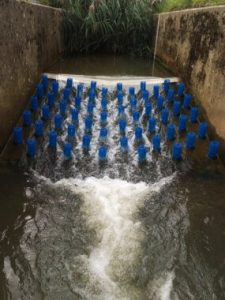Research Article
University of Southampton have developed a new Cylindrical Bristle Cluster (CBC) fish pass that is installed on gauging weirs to enhance passability for fish by reducing drag without impacting weir function. Funded by the UK Environment Agency (EA).
Abstract
Globally, gauging weirs are commonly installed in rivers to monitor flows. They have widespread negative impacts on the upstream movement of fish due to the barriers created by the unfavourable hydraulic conditions on the downstream face. There is a need to develop simple low-cost solutions to enhance multi-species fish passage, while not impacting the ability of these structures to gauge flow or increasing their potential to accumulate debris.
This study investigated the use of an array of Cylindrical Bristle Clusters (CBCs), mounted on the downstream face of Crump weirs, to improve upstream passage of multiple species of fish while maintaining gauging accuracy. The simplicity and modularity of the design helps improve cost effectiveness and ease of installation. Laboratory tests with roach (Rutilus rutilus) showed that the passage efficiency of a Crump weir was increased from 0% (control) to ≈30% when retrofitted with CBCs. Swim path analysis indicated fish utilised low velocity zones in the wake of clusters to facilitate passage. Time taken to pass the weir and length of the swim path were greatest under the highest cluster density, where manoeuvrability was most constrained. Following these promising experimental results, the fish pass efficiency of a weir retrofitted with a staggered array of CBCs, was evaluated in the field. Upstream passage of a number of non-salmonid fish, including chub (Squalius cephalus) and roach, was monitored using Passive Integrated Transponder telemetry at a 7 m long, 1.2 m wide, Crump weir with a 1:5 downstream slope. Overall passage efficiency, considering all species, increased from 2% to 14% when the fish pass was installed, and for chub from 0 to 52%. Debris accumulation was minimal during the test period. Assessment of the impact of a variety of CBC array densities on gauging was also undertaken. As predicted using theory, there was no effect on gauging when arrays were placed downstream of the point at which flow regime changes from sub- to supercritical. This study highlights the potential for a staggered array of CBCs to improve the upstream passage of multiple species of fish at gauging weirs, common barriers to fish migration throughout the world, without affecting the accuracy of flow gauging.


